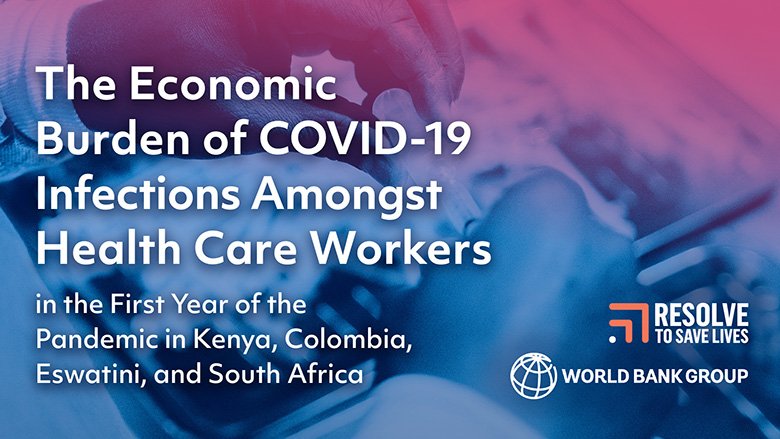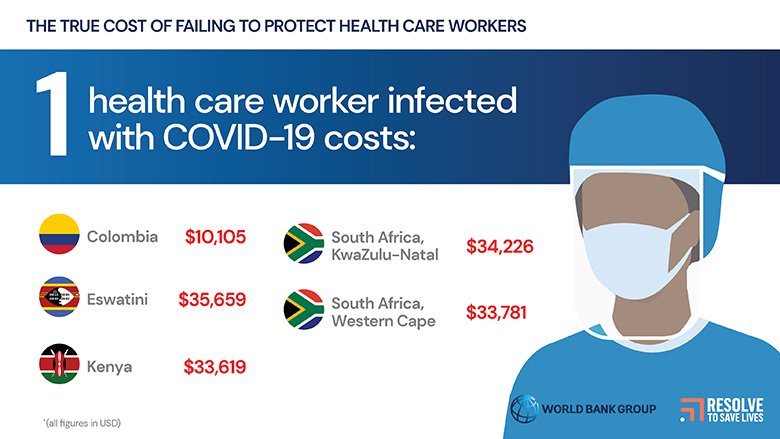Download Report: The Economic Burden of COVID-19 Infections amongst Health Care Workers in the First Year of the Pandemic in Kenya, Colombia, Eswatini, and South Africa

The health workforce is critical to global health security, but around the world, many health care workers (HCWs) lack even basic protections against infectious disease. The consequences are dire: HCWs face disproportionate risk of illness and death, exacerbating both the health and economic impacts of an outbreak, including through increased disease transmission and disruptions to essential health care services.
COVID-19 has proven to be no exception. But despite commitments to increase basic health care worker protections, progress has been limited. What’s urgently needed are safe facilities and health care worker protections, including systematic tracking of HCW infections and deaths, better infection prevention and control measures, adherence to water, sanitation and hygiene (WASH) standards, and comprehensive training, tools and resources for a safer health care workforce.
Protecting health workers benefits the entire society. Governments need to take leadership and responsibility to invest in the protection of health care workers and establish accountability mechanism to ensure measures are being implemented.
Health workers are fundamental to global health security and yet they often lack even basic protections against infectious disease. Countries and health institutions need to prioritize the protection of health care workers with increased investments to avoid deaths, secondary infections, and enormous costs for society at large.
Key messages:
The socio-economic costs associated with COVID-19 infection and death of health care workers (HCWs) have been significant in Kenya, Columbia, Eswatini and South Africa. Beyond the impact to the individuals, HCW infections resulted in broader costs to society.
- The costs of secondary infections and deaths due to the transmission of COVID-19 from HCWs were significant
- Excess maternal and child deaths arising from disrupted essential health services, caused by HCW shortages and diminished productivity, created additional long-term costs
Health care workers were more likely to become infected and die of complications than the general population.
- In Kenya, HCWs were almost 10 times more likely to be infected and in the two provinces of South Africa, the risk was 7–8 times higher. In Colombia, infections rates did not vary greatly between HCWs and the rest of the population, resulting in a lower burden.
- The economic burden of HCW infection was heaviest in the countries that had low HCW density and were most severely affected by staff shortages.
The heaviest costs were associated with secondary infections and excess maternal and child deaths.
- The costs of onward viral transmission outweighed those associated with direct HCW infections, ranging from 13% of total economic costs linked to HCW infections in Kenya to 70% in KwaZulu-Natal, South Africa.
- Increases in maternal and child deaths arising from severe disruptions to essential services such as maternity and under-5 care accounted for 82% of total costs in Kenya – where pre-pandemic mortality levels were already high – against 12% in Columbia and 4%in Western Cape, South Africa.
Overall, COVID-19 infections among health care workers incurred staggering socio-economic costs.
- The report estimates that each HCW infection cost $10,000 in Colombia or 1.5 times the Gross Domestic Product (GDP) per capita. The burden was higher in Kenya where cost was estimated at almost $34,000 or 18 x GDP per capita and in Eswatini where it was assessed at almost $36,000or 9 x GDP per capita.
- As a percentage of annual health expenditure, the total burden associated with HCW infection and death amounted to 1.5% in Colombia. The ratio was highest in Western Cape, South Africa, at 8.4.
The report demonstrates the importance of prioritizing the protection of health care workers.
- Failure do so results in enormous societal costs, which are largely preventable.

